Applications of DINEOF to Satellite-Derived Chlorophyll-a from a Productive Coastal Region
Abstract
1. Introduction
2. Materials and Methods
2.1. Study Area
2.2. Data Sets
2.2.1. Satellite chla Time Series
2.2.2. In Situ Dataset
2.3. DINEOF
2.3.1. Description and Implementation
- chla reconstruction spanning three years, 2014–2016, for daily and week composite time series (referred to as D3 and W3, respectively); and
- chla reconstruction divided by year for daily and week composite (D12014, D12015, D12016, and W12014, W12015, W12016) images in order to constrain variability and reduce influence of lengthy gaps during the winter months.
2.3.2. Preprocessing
- A mask identifying acceptable pixels to be reconstructed. Mask layers were defined to distinguish land from sea pixels, and to exclude individual ocean pixels present in less than 2% of the chlasat scenes. These masks were unified to identify valid sea pixels common to all input datasets.
- chlasat cross-validation (chlaxval) pixels identified randomly throughout each input dataset. For consistency between the same form (e.g., daily or week composite), chlaxval were identified for individual years and concatenated for the corresponding three-year reconstruction.
- A temporal ID of each chlasat image in the time series. The time increment of each chlasat image was specified by using day number as time step for D1/D3, and week number for W1/W3.
2.4. Evaluation of Reconstructions
2.4.1. Reconstruction Statistics and Comparison to chlasat
2.4.2. In Situ Comparison
3. Results
3.1. DINEOF Reconstruction Statistics
3.2. Spatiotemporal Accuracy of DINEOF Products
3.3. DINEOF-Reconstructed and In Situ Data
4. Discussion
4.1. Satellite-Derived versus DINEOF-Reconstructed chla
- More spatial and temporal data allows physical processes to be more clearly resolved in time and space. As the degrees of freedom increase with longer time series, a higher number of EOFs can be calculated [8,47]. Consequently, finer-scale features (e.g., spatially localized events of shorter duration) and greater variance of the input dataset is captured, resulting in more accurate reconstructions. Additionally, differences in reconstruction accuracy year to year depended on the annual differences in input data. For example, 2016 demonstrated the highest R2 and slope closest to 1.0 for the D3 (R2 0.92, slope 0.89), W1 (R2 0.65, slope 0.63), and W3 (R2 0.71, slope 0.69) reconstructions (Table 3), corresponding to the year with lowest percent missing data (71.65% and 37.82% for D12016 and W12016, respectively; Table 1).
- Poorly represented processes are more difficult to reconstruct. Week composite time series are more poorly reconstructed for this reason, as images often display spatially heterogeneous image features as a result of averaging the daily chlasat scenes used in the binning process [2] (e.g., Figure 5d–f). EOF reconstruction methods usually produce spatially smoothed datasets, making spatial discontinuities more difficult to capture, particularly when only few EOF modes are calculated due to dataset size constraints. The long winter gaps present in D3 and W3 reconstructions also contribute to poorly constrained temporal EOFs.
4.2. Accuracy of chlasat and Reconstructed Products
5. Conclusions
Author Contributions
Funding
Acknowledgments
Conflicts of Interest
Appendix A
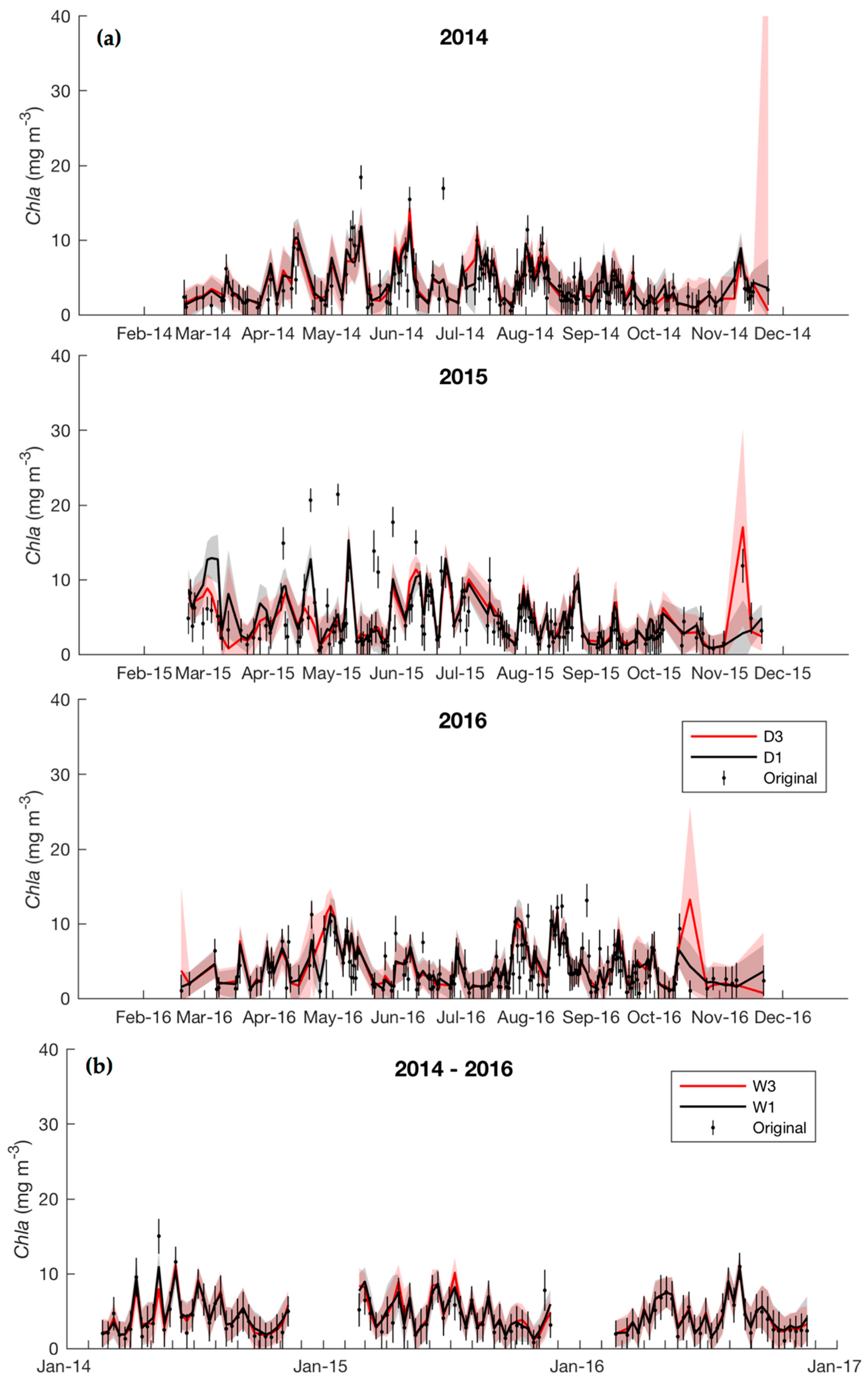
References
- Mélin, F.; Vantrepotte, V.; Chuprin, A.; Grant, M.; Jackson, T.; Sathyendranath, S. Assessing the Fitness-for-Purpose of Satellite Multi-Mission Ocean Color Climate Data Records: A Protocol Applied to OC-CCI Chlorophyll-a Data. Remote Sens. Environ. 2017. [Google Scholar] [CrossRef] [PubMed]
- Sirjacobs, D.; Alvera-Azcárate, A.; Barth, A.; Lacroix, G.; Park, Y.; Nechad, B.; Ruddick, K.; Beckers, J.M. Cloud Filling of Ocean Colour and Sea Surface Temperature Remote Sensing Products over the Southern North Sea by the Data Interpolating Empirical Orthogonal Functions Methodology. J. Sea Res. 2011, 65, 114–130. [Google Scholar] [CrossRef]
- IOCCG. IOCCG Report Number 4: Guide to the Creation and Use of Ocean-Colour, Level-3, Binned Data Products; Antoine, D., Ed.; IOCCG: Dartmouth, DC, Canada, 2004. [Google Scholar]
- Kahru, M.; Kudela, R.M.; Manzano-Sarabia, M.; Greg Mitchell, B. Trends in the Surface Chlorophyll of the California Current: Merging Data from Multiple Ocean Color Satellites. Deep. Res. Part II Top. Stud. Oceanogr. 2012, 77–80, 89–98. [Google Scholar] [CrossRef]
- Bennett, A.F. Inverse Modeling of the Ocean and Atmosphere, 1st ed.; Cambridge University Press: Cambridge, UK, 2002. [Google Scholar]
- Casey, B.; Arnone, R.; Flynn, P. Simple and Efficient Technique for Spatial/Temporal Composite Imagery. Proc. SPIE 2007, 6680, 1–8. [Google Scholar] [CrossRef]
- Müller, D. Estimation of Algae Concentration in Cloud Covered Scenes Using Geostatistical Methods. In Proceedings of the Envisat Symposium 2007, Montreux, Switzerland, 23–27 April 2007. [Google Scholar]
- Taylor, M.H.; Losch, M.; Wenzel, M.; Schröter, J.; Taylor, M.H.; Losch, M.; Wenzel, M.; Schröter, J. On the Sensitivity of Field Reconstruction and Prediction Using Empirical Orthogonal Functions Derived from Gappy Data. J. Clim. 2013, 26, 9194–9205. [Google Scholar] [CrossRef]
- Beckers, J.M.; Rixen, M. EOF Calculations and Data Filling from Incomplete Oceanographic Datasets. J. Atmos. Ocean. Technol. 2003, 20, 1839–1856. [Google Scholar] [CrossRef]
- Alvera-Azcárate, A.; Barth, A.; Rixen, M.; Beckers, J.M. Reconstruction of Incomplete Oceanographic Data Sets Using Empirical Orthogonal Functions: Application to the Adriatic Sea Surface Temperature. Ocean Model. 2005, 9, 325–346. [Google Scholar] [CrossRef]
- Beckers, J.M.; Barth, A.; Alvera-Azcárate, A. DINEOF Reconstruction of Clouded Images Including Error Maps. Application to the Sea-Surface Temperature around Corsican Island. Ocean Sci. Discuss. 2006, 2, 183–199. [Google Scholar] [CrossRef]
- Ganzedo, U.; Alvera-Azcárate, A.; Esnaola, G.; Ezcurra, A.; Sáenz, J. Reconstruction of Sea Surface Temperature by Means of DINEOF: A Case Study during the Fishing Season in the Bay of Biscay. Int. J. Remote Sens. 2011, 32, 933–950. [Google Scholar] [CrossRef]
- Li, Y.; He, R. Spatial and Temporal Variability of SST and Ocean Color in the Gulf of Maine Based on Cloud-Free SST and Chlorophyll Reconstructions in 2003–2012. Remote Sens. Environ. 2014, 144, 98–108. [Google Scholar] [CrossRef]
- Alvera-Azcárate, A.; Barth, A.; Parard, G.; Beckers, J.M. Analysis of SMOS Sea Surface Salinity Data Using DINEOF. Remote Sens. Environ. 2016, 180, 137–145. [Google Scholar] [CrossRef]
- Corredor-Acosta, A.; Morales, C.E.; Hormazabal, S.; Andrade, I.; Correa-Ramirez, M.A. Phytoplankton Phenology in the Coastal Upwelling Region off Central-Southern Chile (35S–38S): Time-Space Variability, Coupling to Environmental Factors, and Sources of Uncertainty in the Estimates. J. Geophys. Res. C Ocean. 2015, 120, 813–831. [Google Scholar] [CrossRef]
- Waite, J.N.; Mueter, F.J. Spatial and Temporal Variability of Chlorophyll-a Concentrations in the Coastal Gulf of Alaska, 1998–2011, Using Cloud-Free Reconstructions of SeaWiFS and MODIS-Aqua Data. Prog. Oceanogr. 2013, 116, 179–192. [Google Scholar] [CrossRef]
- Liu, X.; Wang, M. Gap Filling of Missing Data for VIIRS Global Ocean Color Products Using the DINEOF Method. IEEE Trans. Geosci. Remote Sens. 2018, 56, 4464–4476. [Google Scholar] [CrossRef]
- Alvera-Azcárate, A.; Vanhellemont, Q.; Ruddick, K.; Barth, A.; Beckers, J.M. Analysis of High Frequency Geostationary Ocean Colour Data Using DINEOF. Estuar. Coast. Shelf Sci. 2015, 159, 28–36. [Google Scholar] [CrossRef]
- Nechad, B.; Alvera-Azcárate, A.; Ruddick, K.; Greenwood, N. Reconstruction of MODIS Total Suspended Matter Time Series Maps by DINEOF and Validation with Autonomous Platform Data. Ocean Dyn. 2011, 61, 1205–1214. [Google Scholar] [CrossRef]
- Shropshire, T.; Li, Y.; He, R. Storm Impact on Sea Surface Temperature and Chlorophyll a in the Gulf of Mexico and Sargasso Sea Based on Daily Cloud-Free Satellite Data Reconstructions. Geophys. Res. Lett. 2016, 43, 12199–12207. [Google Scholar] [CrossRef]
- Miles, T.N.; He, R.; Li, M. Characterizing the South Atlantic Bight Seasonal Variability and Cold-Water Event in 2003 Using a Daily Cloud-Free SST and Chlorophyll Analysis. Geophys. Res. Lett. 2009, 36, 1–6. [Google Scholar] [CrossRef]
- Huynh, H.-N.T.; Alvera-Azcárate, A.; Barth, A.; Beckers, J.-M. Reconstruction and Analysis of Long-Term Satellite-Derived Sea Surface Temperature for the South China Sea. J. Oceanogr. 2016, 72, 707–726. [Google Scholar] [CrossRef]
- Mauri, E.; Poulain, P.M.; Južnič-Zonta, Ž. MODIS Chlorophyll Variability in the Northern Adriatic Sea and Relationship with Forcing Parameters. J. Geophys. Res. Ocean. 2007, 112, 1–14. [Google Scholar] [CrossRef]
- Johannessen, S.C.; Macdonald, R.W.; Paton, D.W. A Sediment and Organic Carbon Budget for the Greater Strait of Georgia. Estuar. Coast. Shelf Sci. 2003, 56, 845–860. [Google Scholar] [CrossRef]
- Masson, D. Seasonal Water Mass Analysis for the Straits of Juan de Fuca and Georgia. Atmosphere 2006, 44, 1–15. [Google Scholar] [CrossRef]
- Porter, A.D.; Rechisky, E.L.; Winchell, P.; Welch, D.W. The Use of Telemetry to Investigate Residence Time and Survival of Fraser River Chinook Salmon in the Strait of Georgia, 2016: Final Report to the Pacific Salmon Foundation and the Salish Sea Marine Survival Project; Kintama Research Services: Nanaimo, BC, Canada, 2016. [Google Scholar]
- Yin, K.; Goldblatt, R.H.; Harrison, P.J.; St. John, M.A.; Clifford, P.J.; Beamish, R.J. Importance of Wind and River Discharge in Influencing Nutrient Dynamics and Phytoplankton Production in Summer in the Central Strait of Georgia. Mar. Ecol. Prog. Ser. 1997, 161, 173–183. [Google Scholar] [CrossRef]
- Collins, A.K.; Allen, S.E.; Pawlowicz, R. The Role of Wind in Determining the Timing of the Spring Bloom in the Strait of Georgia. Can. J. Fish. Aquat. Sci. 2009, 66, 1597–1616. [Google Scholar] [CrossRef]
- Li, M.; Gargett, A.; Denman, K. What Determines Seasonal and Interannual Variability of Phytoplankton and Zooplankton in Strongly Estuarine Systems? Application to the Semi-Enclosed Estuary of Strait of Georgia and Juan de Fuca Strait. Estuar. Coast. Shelf Sci. 2000, 50, 467–488. [Google Scholar] [CrossRef]
- Allen, S.E.; Wolfe, M.A. Hindcast of the Timing of the Spring Phytoplankton Bloom in the Strait of Georgia, 1968–2010. Prog. Oceanogr. 2013, 115, 6–13. [Google Scholar] [CrossRef]
- Perry, R.I. Plankton Blooms of the British Columbia Northern Shelf: Seasonal Distributions and Mechanisms Influencing Their Formation; University of British Columbia: Vancouver, BC, Canada, 1984. [Google Scholar]
- Mackas, D.L.; Louttit, G.C.; Austin, M.J. Spatial Distribution of Zooplankton and Phytoplankton in British Columbian Coastal Waters. Can. J. Fish. Aquat. Sci. 1980, 37, 1476–1487. [Google Scholar] [CrossRef]
- Phillips, S.R.; Costa, M. Spatial-Temporal Bio-Optical Classification of Dynamic Semi-Estuarine Waters in Western North America. Estuar. Coast. Shelf Sci. 2017, 199, 35–48. [Google Scholar] [CrossRef]
- Loos, E.A.; Costa, M. Inherent Optical Properties and Optical Mass Classification of the Waters of the Strait of Georgia, British Columbia, Canada. Prog. Oceanogr. 2010, 87, 144–156. [Google Scholar] [CrossRef]
- Carswell, T.; Costa, M.; Young, E.; Komick, N.; Gower, J.; Sweeting, R. Evaluation of MODIS-Aqua Atmospheric Correction and Chlorophyll Products of Western North American Coastal Waters Based on 13 Years of Data. Remote Sens. 2017, 9, 1063. [Google Scholar] [CrossRef]
- NASA Ocean Color. Available online: https://oceancolor.gsfc.nasa.gov/ (accessed on 1 September 2015).
- NASA SeaDAS. Available online: https://seadas.gsfc.nasa.gov/ (accessed on 1 September 2015).
- Komick, N.M. Remote Sensing Chlorophyll-a in the Strait of Georgia; University of Victoria: Victoria, BC, Canada, 2007. [Google Scholar]
- Komick, N.M.; Costa, M.P.F.; Gower, J. Bio-Optical Algorithm Evaluation for MODIS for Western Canada Coastal Waters: An Exploratory Approach Using in Situ Reflectance. Remote Sens. Environ. 2009, 113, 794–804. [Google Scholar] [CrossRef]
- Meister, G.; Zong, Y.; McClain, C.R. Derivation of the MODIS Aqua Point-Spread Function for Ocean Color Bands. Proc. SPIE 2008, 7081, 70811F-1–70811F-12. [Google Scholar] [CrossRef]
- Fisheries and Oceans Canada, Pacific Region, OSD. Institute of Ocean Sciences Data Archive. Available online: http://www.pac.dfo-mpo.gc.ca/science/oceans/data-donnees/search-recherche/profiles-eng.asp (accessed on 28 August 2017).
- Barwell-Clarke, J.; Whitney, F. Canadian Technical Report of Hydrography and Ocean Sciences No. 182, Institute of Ocean Sciences Nutrient Methods and Analysis; Institute of Ocean Sciences: Sidney, BC, Canada, 1996. [Google Scholar]
- Holm-Hansen, O.; Lorenzen, C.J.; Holmes, R.W.; Strickland, J.D.H. Fluorometric Determination of Chlorophyll. J. Cons. Perm. Int. Explor. Mer. 1965, 30, 3–15. [Google Scholar] [CrossRef]
- Alvera-Azcárate, A.; Barth, A.; Sirjacobs, D.; Lenartz, F.; Beckers, J.-M. Data Interpolating Empirical Orthogonal Functions (DINEOF): A Tool for Geophysical Data Analyses. Medit. Mar. Sci. Spec. Issue 2011, 5–11. [Google Scholar] [CrossRef]
- DINEOF—GHER. Available online: http://modb.oce.ulg.ac.be/mediawiki/index.php/DINEOF (accessed on 1 October 2016).
- Campbell, J.W. The Lognormal Distribution as a Model for Bio-Optical Variability in the Se. J. Geophys. Res. Oceans 1995, 100, 237–254. [Google Scholar] [CrossRef]
- Alvera-Azcárate, A.; Barth, A.; Sirjacobs, D.; Beckers, J.-M. Enhancing Temporal Correlations in EOF Expansions for the Reconstruction of Missing Data Using DINEOF. Ocean Sci. Discuss. 2009, 6, 1547–1568. [Google Scholar] [CrossRef]
- Wilks, D.S. Statistical Methods in the Atmospheric Sciences, 2nd ed.; Academic Press: London, UK, 2006. [Google Scholar]
- Brewin, R.J.W.; Mélin, F.; Sathyendranath, S.; Steinmetz, F.; Chuprin, A.; Grant, M. On the Temporal Consistency of Chlorophyll Products Derived from Three Ocean-Colour Sensors. ISPRS J. Photogramm. Remote Sens. 2014, 97, 171–184. [Google Scholar] [CrossRef]
- Bailey, S.W.; Werdell, P.J. A Multi-Sensor Approach for the on-Orbit Validation of Ocean Color Satellite Data Products. Remote Sens. Environ. 2006, 102, 12–23. [Google Scholar] [CrossRef]
- Werdell, P.J.; Bailey, S.W.; Franz, B.A.; Harding, L.W.; Feldman, G.C.; McClain, C.R. Regional and Seasonal Variability of Chlorophyll-a in Chesapeake Bay as Observed by SeaWiFS and MODIS-Aqua. Remote Sens. Environ. 2009, 113, 1319–1330. [Google Scholar] [CrossRef]
- Wang, Y.; Liu, D. Reconstruction of Satellite Chlorophyll-a Data Using a Modified DINEOF Method: A Case Study in the Bohai and Yellow Seas, China. Int. J. Remote Sens. 2014, 35, 204–217. [Google Scholar] [CrossRef]
- Marchese, C.; Albouy, C.; Tremblay, J.-É.; Dumont, D.; D’Ortenzio, F.; Vissault, S.; Bélanger, S. Changes in Phytoplankton Bloom Phenology over the North Water (NOW) Polynya: A Response to Changing Environmental Conditions. Polar Biol. 2017, 40, 1721–1737. [Google Scholar] [CrossRef]
- Strang, G. Linear Algebra and Its Applications, 3rd ed.; Harcourt-Brace-Jovanovich: San Diego, CA, USA, 1988. [Google Scholar]
- Mauri, E.; Poulain, P.-M.; Notarstefano, G. Spatial and Temporal Variability of the Sea Surface Temperature in the Gulf of Trieste between January 2000 and December 2006. J. Geophys. Res. 2008, 113. [Google Scholar] [CrossRef]
- Ping, B.; Su, F.; Meng, Y. An Improved DINEOF Algorithm for Filling Missing Values in Spatio-Temporal Sea Surface Temperature Data. PLoS ONE 2016, 11. [Google Scholar] [CrossRef] [PubMed]
- Land, P.; Bailey, T.; Taberner, M.; Pardo, S.; Sathyendranath, S.; Nejabati Zenouz, K.; Brammall, V.; Shutler, J.; Quartly, G. A Statistical Modeling Framework for Characterising Uncertainty in Large Datasets: Application to Ocean Colour. Remote Sens. 2018, 10, 695. [Google Scholar] [CrossRef]
- Jackson, J.M.; Thomson, R.E.; Brown, L.N.; Willis, P.G.; Borstad, G.A. Satellite Chlorophyll off the British Columbia Coast, 1997–2010. J. Geophys. Res. Ocean. 2015, 120, 4709–4728. [Google Scholar] [CrossRef]
- Alvera-Azcárate, A.; Sirjacobs, D.; Barth, A.; Beckers, J.M. Outlier Detection in Satellite Data Using Spatial Coherence. Remote Sens. Environ. 2012, 119, 84–91. [Google Scholar] [CrossRef]
- Wang, Y.; Jiang, H.; Jin, J.; Zhang, X.; Lu, X.; Wang, Y. Spatial-Temporal Variations of Chlorophyll-a in the Adjacent Sea Area of the Yangtze River Estuary Influenced by Yangtze River Discharge. Int. J. Environ. Res. Public Health 2015, 12, 5420–5438. [Google Scholar] [CrossRef] [PubMed]
- McGinty, N.; Guðmundsson, K.; Ágústsdóttir, K.; Marteinsdóttir, G. Environmental and Climactic Effects of Chlorophyll-a Variability around Iceland Using Reconstructed Satellite Data Fields. J. Mar. Syst. 2016, 163, 31–42. [Google Scholar] [CrossRef]
- Gregg, W.W. Assimilation of SeaWiFS Ocean Chlorophyll Data into a Three-Dimensional Global Ocean Model. J. Mar. Syst. 2008, 69, 205–225. [Google Scholar] [CrossRef]
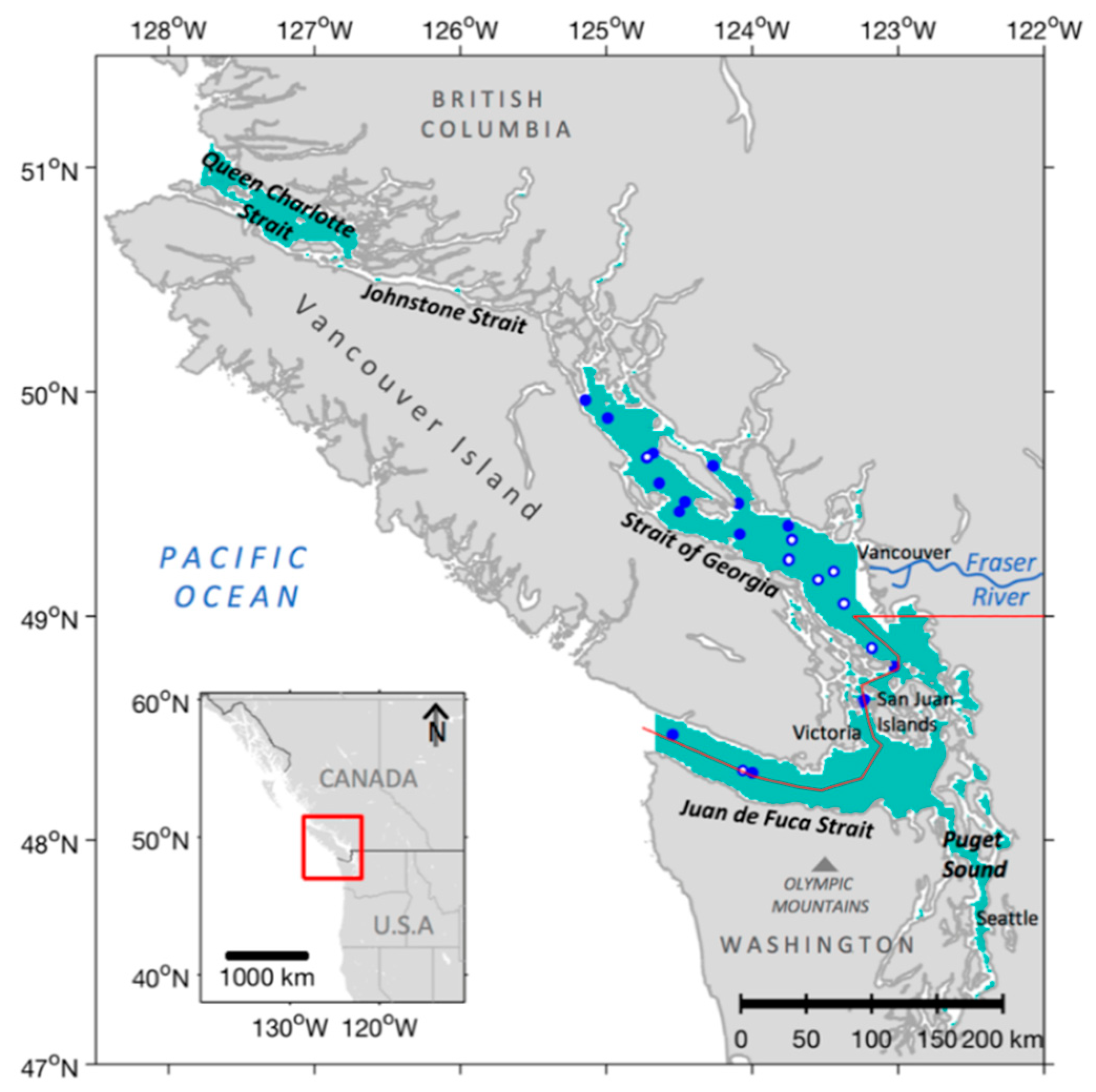
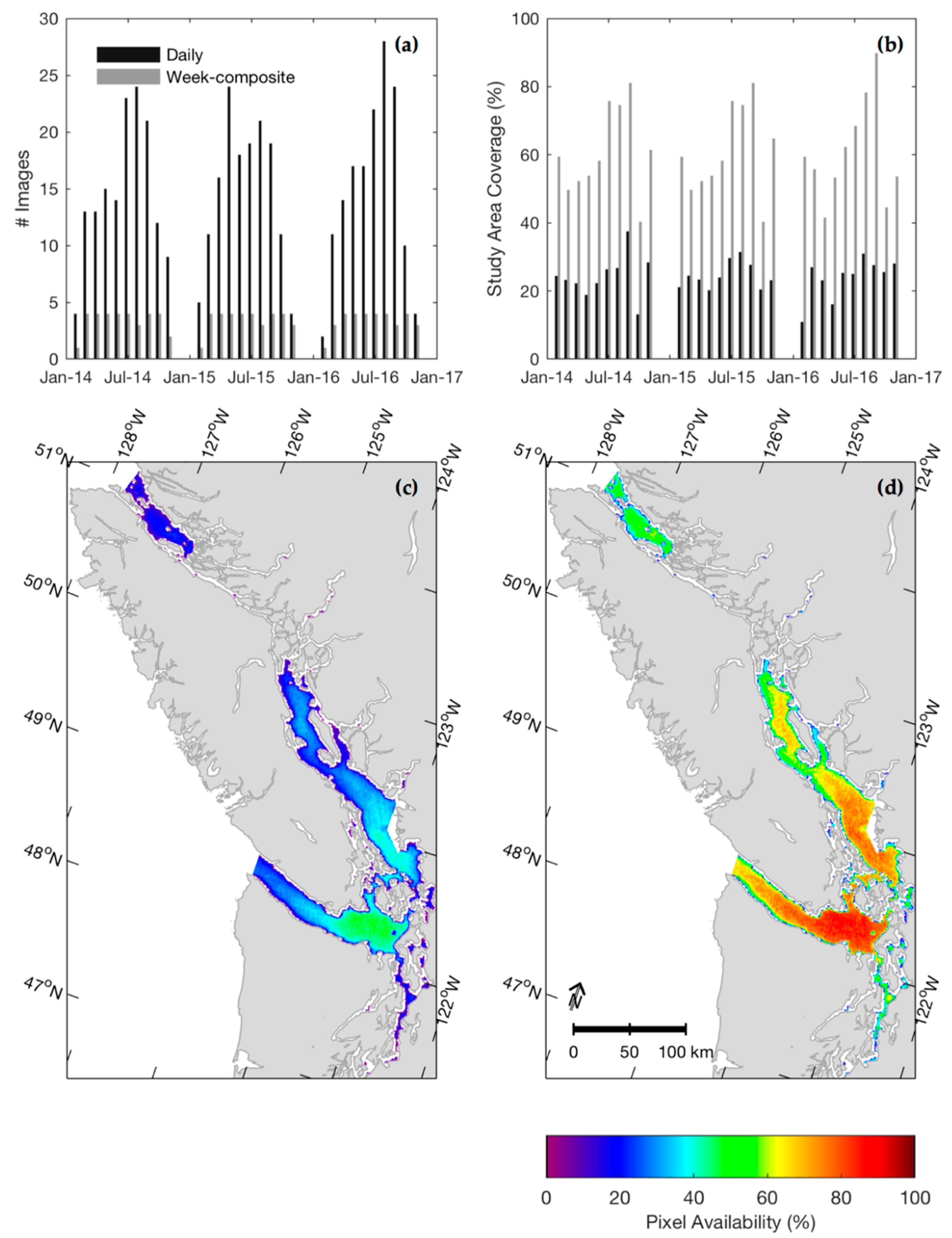
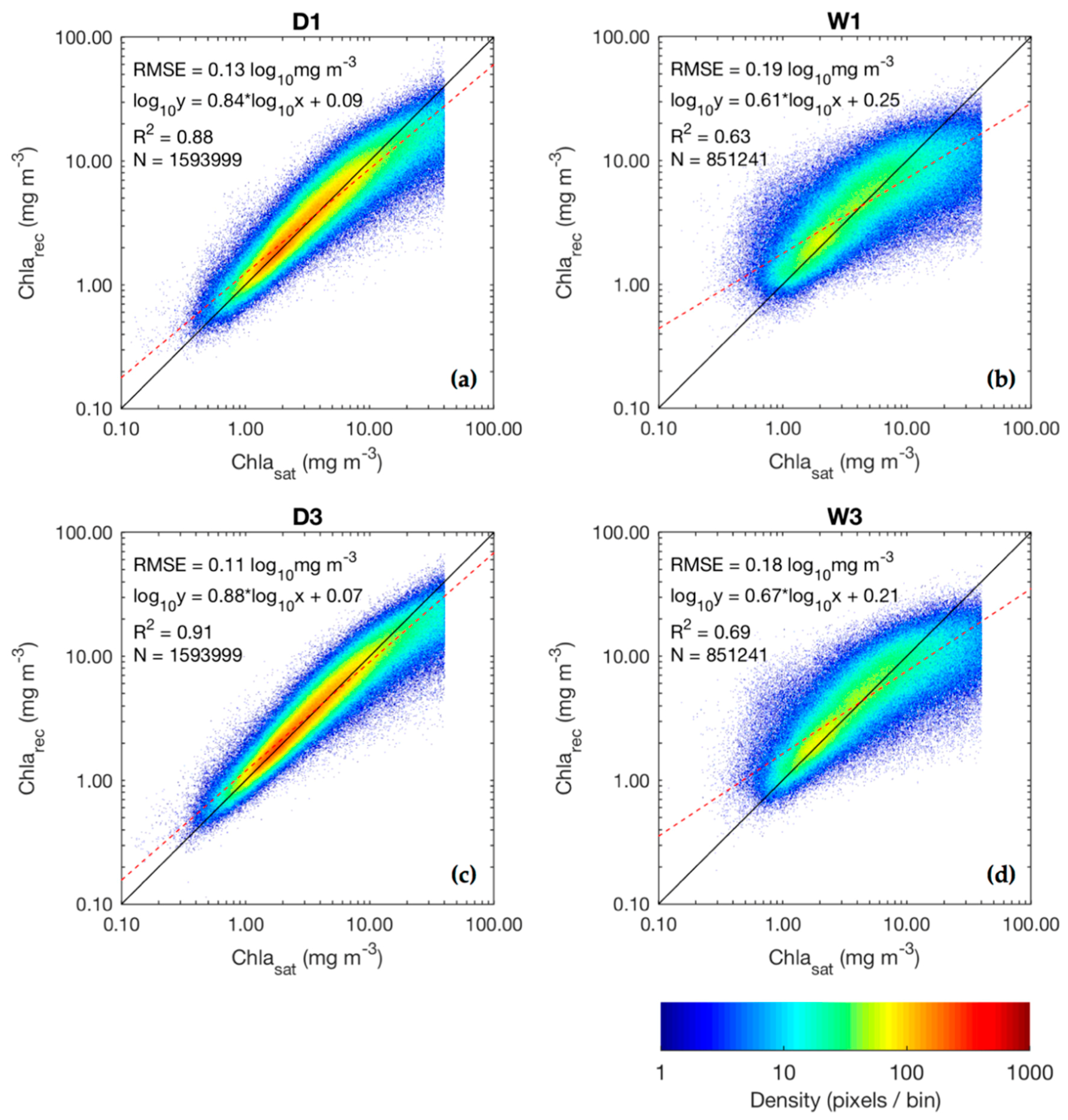
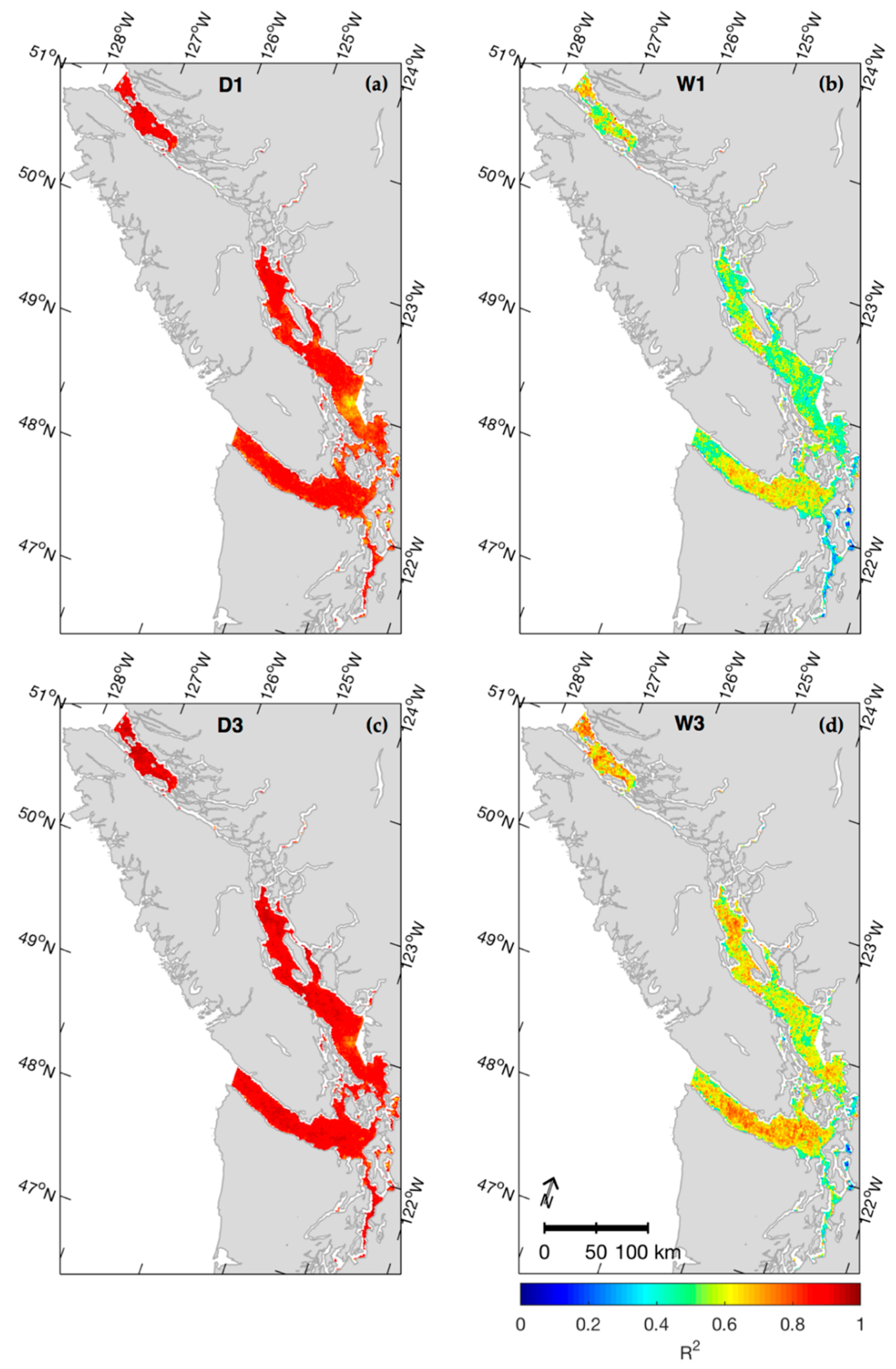
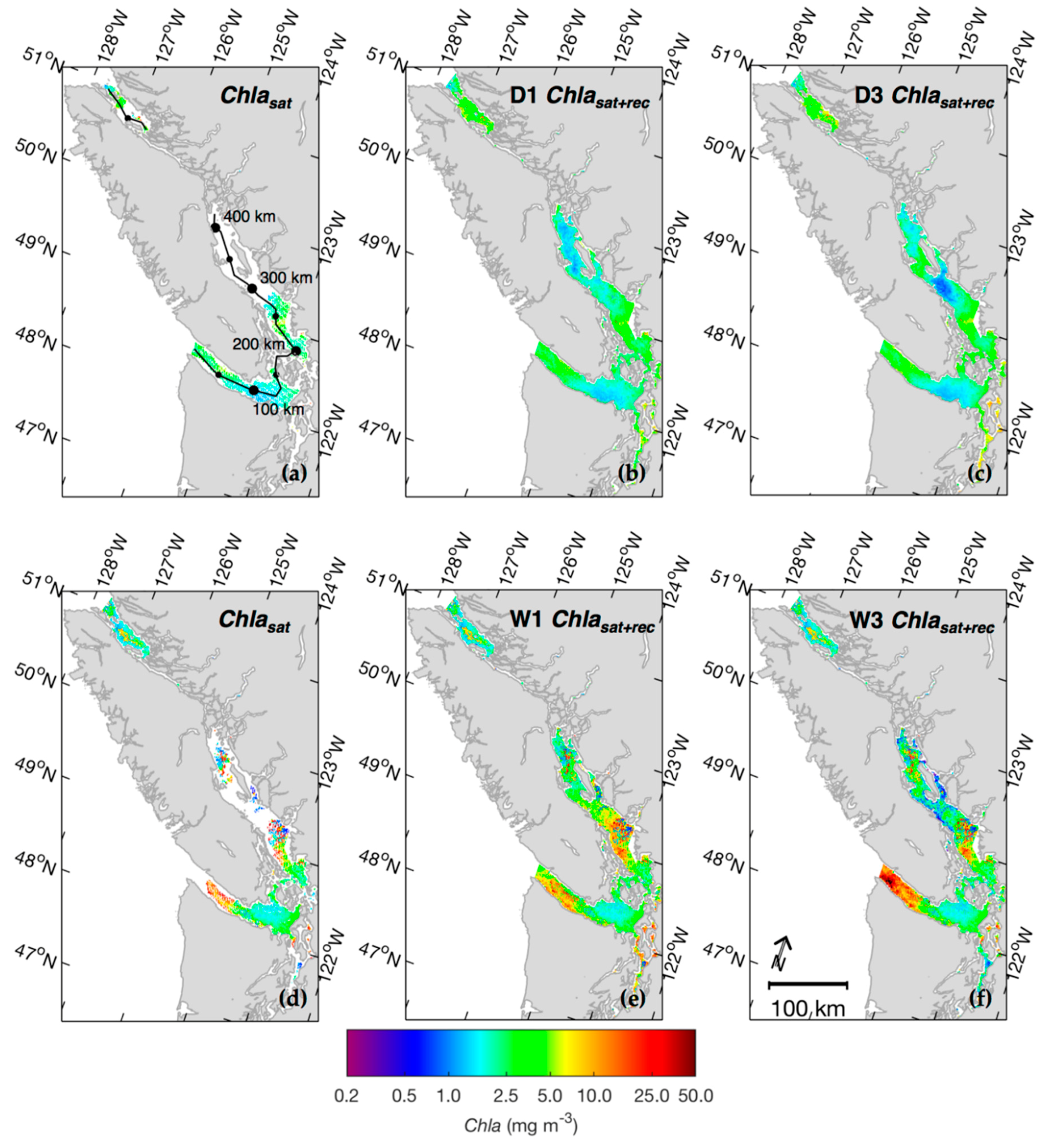
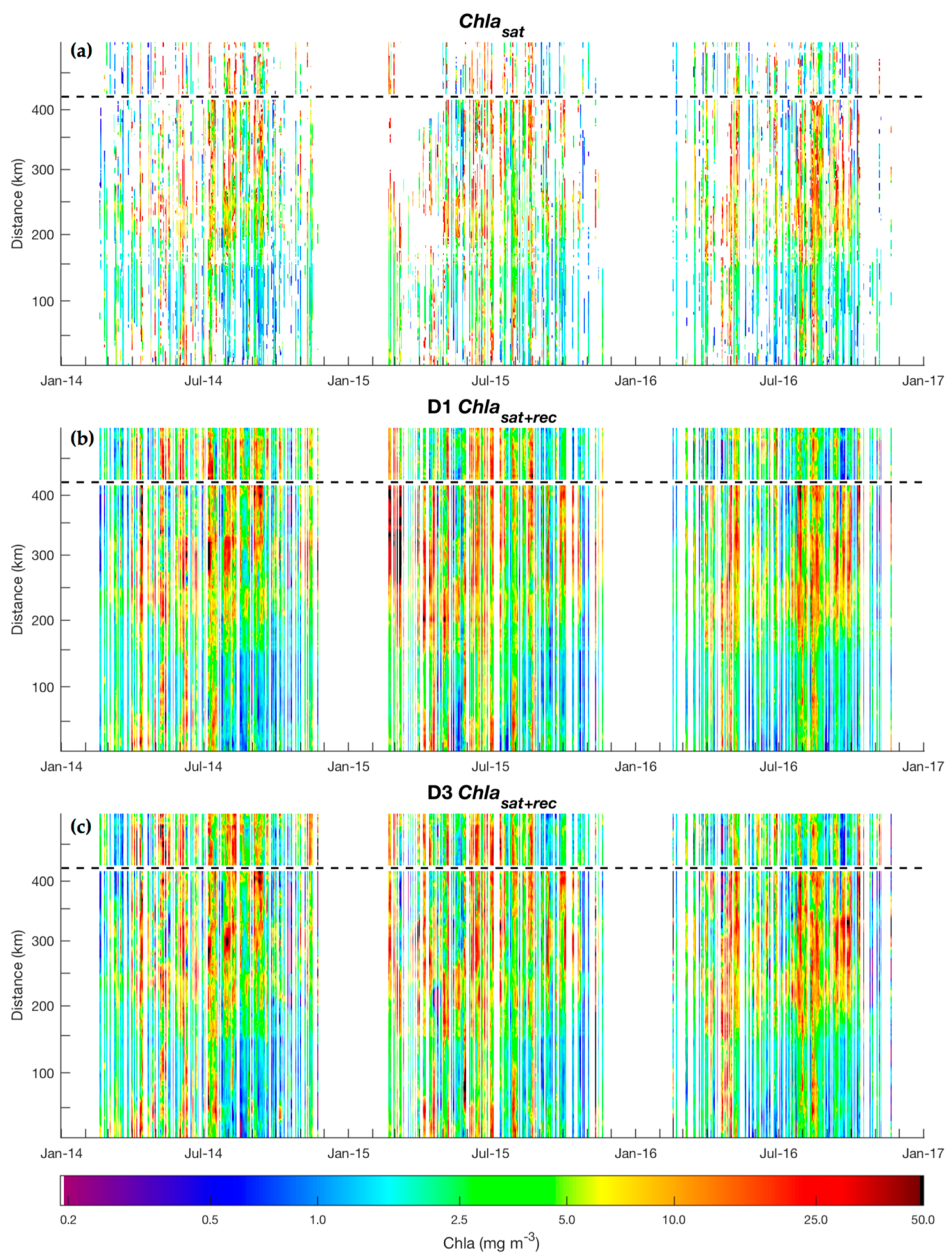
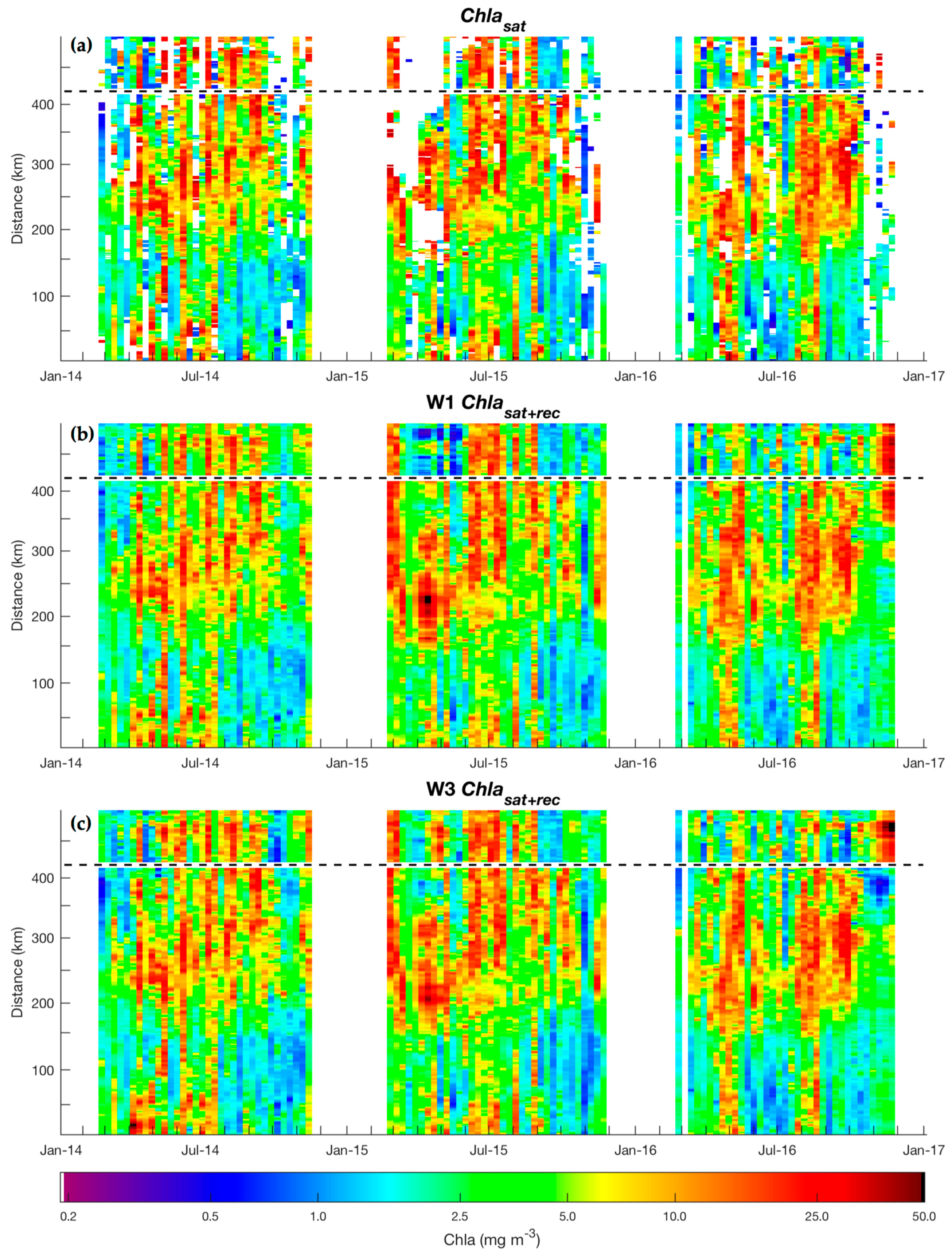

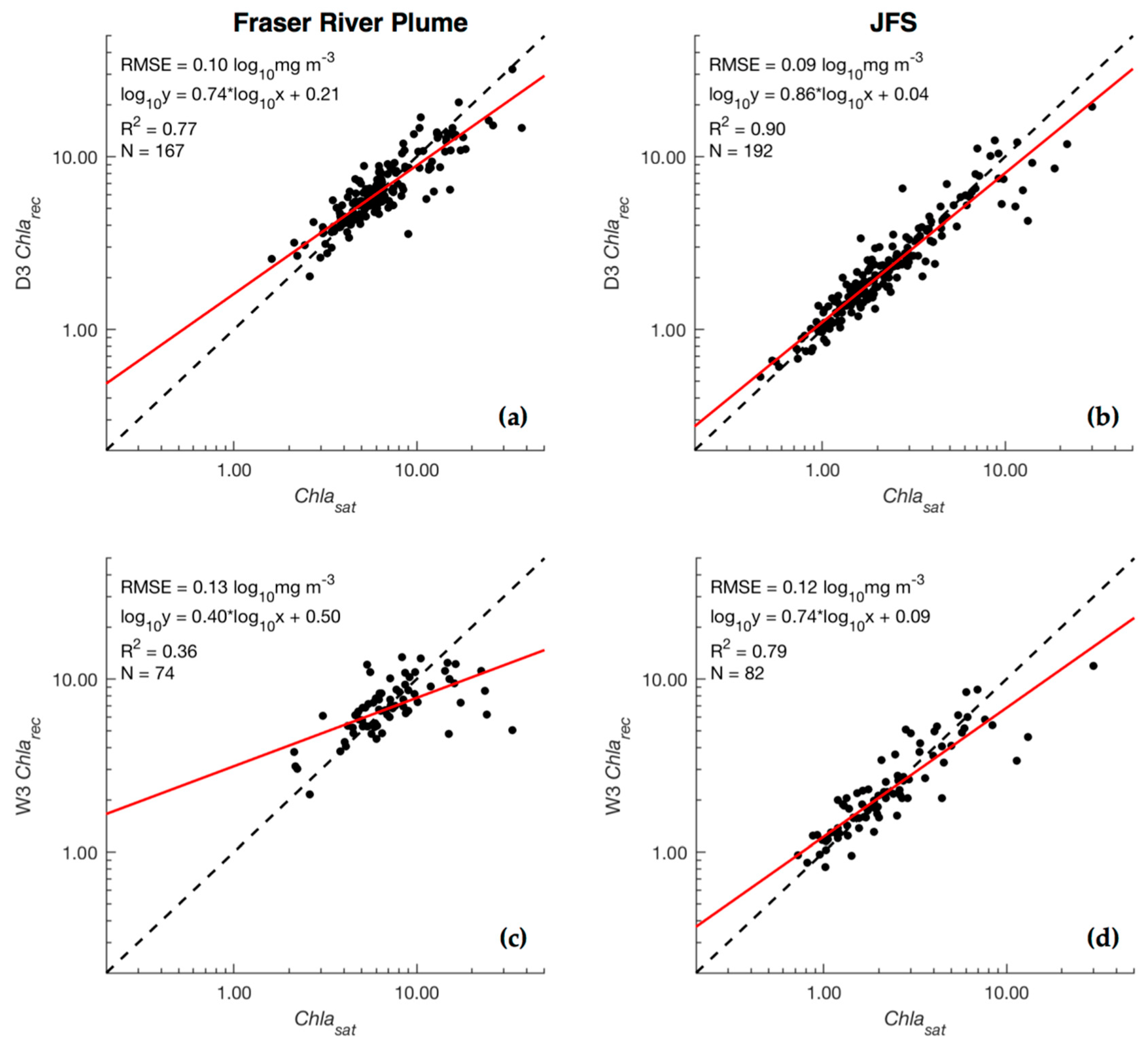
| Period (Year) | N MODISA Scenes | N MODISA Scenes (after 2% Filter) | Missing Pixels (Total Pixels) 1 | Missing Data (%) | |
|---|---|---|---|---|---|
| D12014 | 2014 | 185 | 148 | 15.32 (20.49) | 74.77 |
| D12015 | 2015 | 168 | 148 | 15.57 (20.49) | 75.99 |
| D12016 | 2016 | 187 | 149 | 14.78 (20.6) | 71.65 |
| D3 | 2014–2016 | 540 | 445 | 45.67 (61.61) | 74.13 |
| W12014 | 2014 | 35 | 34 | 1.87 (4.71) | 39.67 |
| W12015 | 2015 | 35 | 35 | 2.10 (4.85) | 43.36 |
| W12016 | 2016 | 35 | 34 | 1.78 (4.71) | 37.82 |
| W3 | 2014–2016 | 105 | 103 | 5.75 (14.26) | 40.31 |
| Explained Variance (%) | Calculated EOFs (#) | RMSExval (log10 mg m−3) | RMSExval (mg m−3) | |
|---|---|---|---|---|
| D12014 | 96.05 | 11 | 0.22 | 1.65 |
| D12015 | 96.33 | 9 | 0.21 | 1.61 |
| D12016 | 95.08 | 9 | 0.20 | 1.58 |
| D3 | 97.08 | 26 | 0.17 | 1.49 |
| W12014 | 68.99 | 3 | 0.32 | 2.07 |
| W12015 | 74.68 | 3 | 0.30 | 1.98 |
| W12016 | 73.52 | 3 | 0.29 | 1.95 |
| W3 | 76.88 | 8 | 0.27 | 1.87 |
| (a) | R2 | RMSE (log10 mg m−3) | RMSE (mg m−3) | Slope | Intercept | (b) | R2 | RMSE (log10 mg m−3) | RMSE (mg m−3) | Slope | Intercept |
|---|---|---|---|---|---|---|---|---|---|---|---|
| D12014 | 0.88 | 0.13 | 1.35 | 0.85 | 0.08 | W12014 | 0.61 | 0.20 | 1.58 | 0.59 | 0.25 |
| D32014 | 0.91 | 0.11 | 1.29 | 0.88 | 0.07 | W32014 | 0.70 | 0.19 | 1.55 | 0.67 | 0.20 |
| D12015 | 0.87 | 0.13 | 1.35 | 0.83 | 0.10 | W12015 | 0.62 | 0.19 | 1.55 | 0.59 | 0.27 |
| D32015 | 0.91 | 0.11 | 1.29 | 0.87 | 0.07 | W32015 | 0.67 | 0.18 | 1.51 | 0.64 | 0.23 |
| D12016 | 0.87 | 0.13 | 1.35 | 0.84 | 0.09 | W12016 | 0.65 | 0.19 | 1.55 | 0.63 | 0.23 |
| D32016 | 0.92 | 0.11 | 1.29 | 0.89 | 0.07 | W32016 | 0.71 | 0.18 | 1.51 | 0.69 | 0.20 |
© 2018 by the authors. Licensee MDPI, Basel, Switzerland. This article is an open access article distributed under the terms and conditions of the Creative Commons Attribution (CC BY) license (http://creativecommons.org/licenses/by/4.0/).
Share and Cite
Hilborn, A.; Costa, M. Applications of DINEOF to Satellite-Derived Chlorophyll-a from a Productive Coastal Region. Remote Sens. 2018, 10, 1449. https://doi.org/10.3390/rs10091449
Hilborn A, Costa M. Applications of DINEOF to Satellite-Derived Chlorophyll-a from a Productive Coastal Region. Remote Sensing. 2018; 10(9):1449. https://doi.org/10.3390/rs10091449
Chicago/Turabian StyleHilborn, Andrea, and Maycira Costa. 2018. "Applications of DINEOF to Satellite-Derived Chlorophyll-a from a Productive Coastal Region" Remote Sensing 10, no. 9: 1449. https://doi.org/10.3390/rs10091449
APA StyleHilborn, A., & Costa, M. (2018). Applications of DINEOF to Satellite-Derived Chlorophyll-a from a Productive Coastal Region. Remote Sensing, 10(9), 1449. https://doi.org/10.3390/rs10091449





